
A local area network (LAN) is a computer network that interconnects computers within a limited area such as a residence, school, laboratory, university campus or office building. By contrast, a wide area network (WAN) not only covers a larger geographic distance, but also generally involves leased telecommunication circuits.
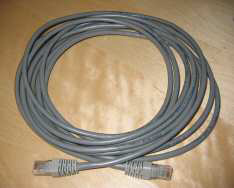
Ethernet over twisted-pair technologies use twisted-pair cables for the physical layer of an Ethernet computer network. They are a subset of all Ethernet physical layers.
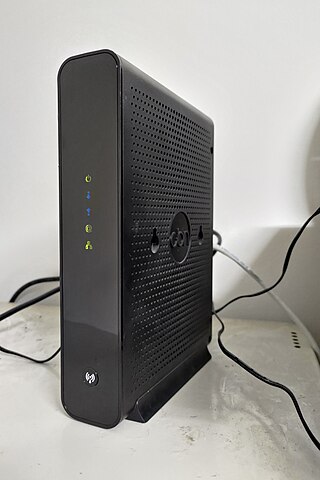
A cable modem is a type of network bridge that provides bi-directional data communication via radio frequency channels on a hybrid fibre-coaxial (HFC), radio frequency over glass (RFoG) and coaxial cable infrastructure. Cable modems are primarily used to deliver broadband Internet access in the form of cable Internet, taking advantage of the high bandwidth of a HFC and RFoG network. They are commonly deployed in the Americas, Asia, Australia, and Europe.

In computer networking, Fast Ethernet physical layers carry traffic at the nominal rate of 100 Mbit/s. The prior Ethernet speed was 10 Mbit/s. Of the Fast Ethernet physical layers, 100BASE-TX is by far the most common.
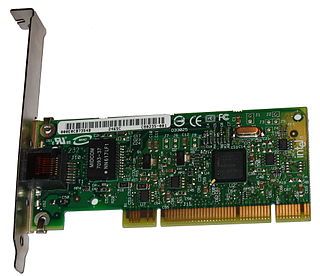
In computer networking, Gigabit Ethernet is the term applied to transmitting Ethernet frames at a rate of a gigabit per second. The most popular variant, 1000BASE-T, is defined by the IEEE 802.3ab standard. It came into use in 1999, and has replaced Fast Ethernet in wired local networks due to its considerable speed improvement over Fast Ethernet, as well as its use of cables and equipment that are widely available, economical, and similar to previous standards. The first standard for faster 10 Gigabit Ethernet was approved in 2002.
Fibre Channel (FC) is a high-speed data transfer protocol providing in-order, lossless delivery of raw block data. Fibre Channel is primarily used to connect computer data storage to servers in storage area networks (SAN) in commercial data centers.

IEEE 802.16 is a series of wireless broadband standards written by the Institute of Electrical and Electronics Engineers (IEEE). The IEEE Standards Board established a working group in 1999 to develop standards for broadband for wireless metropolitan area networks. The Workgroup is a unit of the IEEE 802 local area network and metropolitan area network standards committee.
LattisNet was a family of computer networking hardware and software products built and sold by SynOptics Communications during the 1980s. Examples were the 1000, 2500 and 3000 series of LattisHub network hubs. LattisNet was the first implementation of 10 Megabits per second local area networking over unshielded twisted pair wiring in a star topology.
Autonegotiation is a signaling mechanism and procedure used by Ethernet over twisted pair by which two connected devices choose common transmission parameters, such as speed, duplex mode, and flow control. In this process, the connected devices first share their capabilities regarding these parameters and then choose the highest-performance transmission mode they both support.
In computer networking, jumbo frames are Ethernet frames with more than 1500 bytes of payload, the limit set by the IEEE 802.3 standard. The payload limit for jumbo frames is variable: while 9000 bytes is the most commonly used limit, smaller and larger limits exist. Many Gigabit Ethernet switches and Gigabit Ethernet network interface controllers and some Fast Ethernet switches and Fast Ethernet network interface cards can support jumbo frames.

The physical-layer specifications of the Ethernet family of computer network standards are published by the Institute of Electrical and Electronics Engineers (IEEE), which defines the electrical or optical properties and the transfer speed of the physical connection between a device and the network or between network devices. It is complemented by the MAC layer and the logical link layer. An implementation of a specific physical layer is commonly referred to as PHY.
Ethernet in the first mile (EFM) refers to using one of the Ethernet family of computer network technologies between a telecommunications company and a customer's premises. From the customer's point of view, it is their first mile, although from the access network's point of view it is known as the last mile.
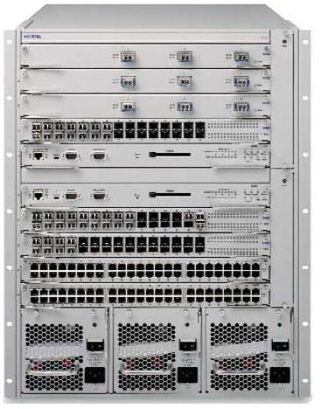
The Avaya Ethernet Routing Switch 8600 or ERS 8600, previously known as the Passport 8600 or the Accelar 8000, is a modular chassis combination hardware router and switch used in computer networking. The system, originally designed and manufactured by Nortel, was manufactured by Avaya from 2009 until 2017. The system provided the 10G Ethernet equipment backbone for the 2010 Winter Olympics games, providing service for 15,000 VoIP Phones, 40,000 Ethernet connections and supporting 1.8 million live spectators. The system is configurable as a 1.440 Terabit Switch cluster using SMLT and R-SMLT protocols, to provide high reliability cluster failover.
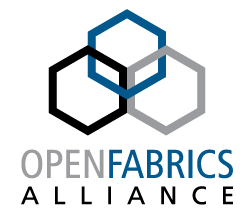
The OpenFabrics Alliance is a non-profit organization that promotes remote direct memory access (RDMA) switched fabric technologies for server and storage connectivity. These high-speed data-transport technologies are used in high-performance computing facilities, in research and various industries.

The Ethernet Alliance was incorporated in the US state of California in August 2005 and officially launched in January 2006 as a non-profit industry consortium to promote and support Ethernet. The objectives were to provide an unbiased, industry-based source of educational information; to ensure interoperability among disparate, standards-based components and systems; to support the development of standards that support Ethernet technology; and to bring together the Ethernet industry to collaborate on the future of the technology.
iSCSI conformance testing is testing to determine whether an iSCSI Initiator/Target meets the iSCSI standard.

The OPEN Alliance is a non-profit, special interest group (SIG) of mainly automotive industry and technology providers collaborating to encourage wide scale adoption of Ethernet-based communication as the standard in automotive networking applications.
Avnu Alliance is a consortium of member companies working together to create an interoperable ecosystem of low-latency, time-synchronized, highly reliable networking devices using the IEEE open standard, Time-Sensitive Networking (TSN) and its Pro AV networking protocol, Milan. Avnu Alliance creates comprehensive certification programs to ensure interoperability of network devices. In the Professional Audio Video (AV) industry, Alliance member companies worked together to develop Milan: a standards-based, user-driven deterministic network protocol for professional media, that through certification, assures devices will work together at new levels of convenience, reliability, and functionality. Milan™ is a standards-based deterministic network protocol for real time media. Avnu Members may use the Avnu-certified or Milan-certified logo on devices that pass the conformance tests from Avnu. Not every device based on AVB or TSN is submitted for certification to the Avnu Alliance. The lack of the Avnu logo does not necessarily imply a device is incompatible with other Avnu-certified devices. The Alliance, in conjunction with other complimentary standards bodies and alliances, provides a united network foundation for use in professional AV, automotive, industrial control and consumer segments.
25 Gigabit Ethernet and 50 Gigabit Ethernet are standards for Ethernet connectivity in a datacenter environment, developed by IEEE 802.3 task forces 802.3by and 802.3cd and are available from multiple vendors.
Classic Ethernet is a family of 10 Mbit/s Ethernet standards, which is the first generation of Ethernet standards. In 10BASE-X, the 10 represents its maximum throughput of 10 Mbit/s, BASE indicates its use of baseband transmission, and X indicates the type of medium used. Classic Ethernet includes coax, twisted pair and optical variants. The first Ethernet standard was published in 1983 and classic Ethernet operating at 10 Mbit/s was the dominant form of Ethernet until the first standard for Fast Ethernet was approved in 1995.











